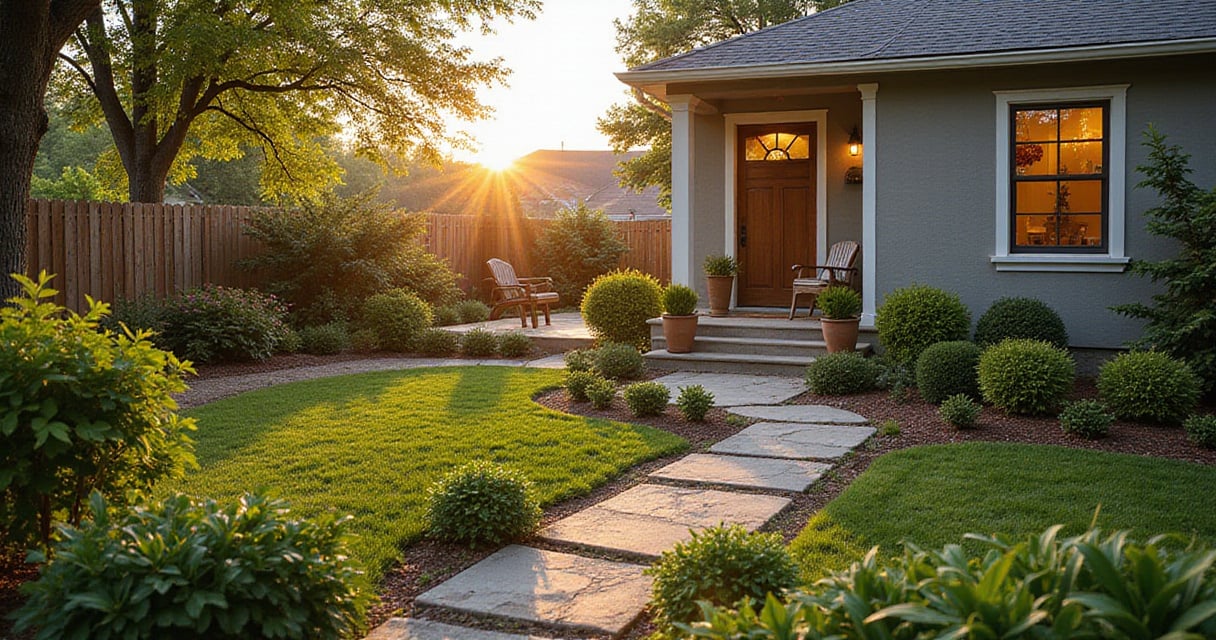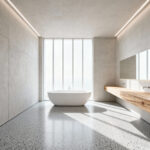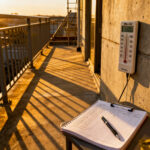The first glimpse of your home tells a story before visitors even reach your front door. That initial impression—captured in the sweep of your driveway, the rhythm of your plantings, and the welcome of your entryway—can either invite exploration or suggest neglect. Your front yard serves as both canvas and stage, where architectural lines meet living beauty, where practical needs blend with aesthetic desires.
Many homeowners find themselves caught between aspiration and uncertainty when it comes to front yard design. The vision is clear: a landscape that enhances their home’s character while reflecting their personal style. Yet the path forward often feels overwhelming, clouded by questions about plant selection, maintenance requirements, and budget considerations. The encouraging truth is that transforming your outdoor space doesn’t demand a complete overhaul or unlimited resources—it requires strategic thinking and informed choices.
In this comprehensive guide, we’ll explore eighteen sophisticated approaches to front yard design, each offering specific techniques for creating lasting impact. From establishing the foundational elements that define your space to incorporating cutting-edge sustainable practices, these strategies will equip you with the knowledge to craft an exterior that commands attention and enhances value. Prepare to discover how thoughtful design choices can elevate your home’s presence while creating an outdoor environment that brings daily pleasure.
1. Define Your Front Yard’s Purpose and Establish Design Direction
Before selecting a single plant or hardscape material, establishing a clear vision for your front yard’s function and aesthetic direction proves essential for creating a cohesive, successful landscape. This foundational step involves analyzing how you’ll use the space, understanding your home’s architectural language, and determining the overall atmosphere you wish to create. Without this clarity, even the most expensive materials and plants can result in a disjointed landscape that fails to enhance your property’s value or meet your lifestyle needs.
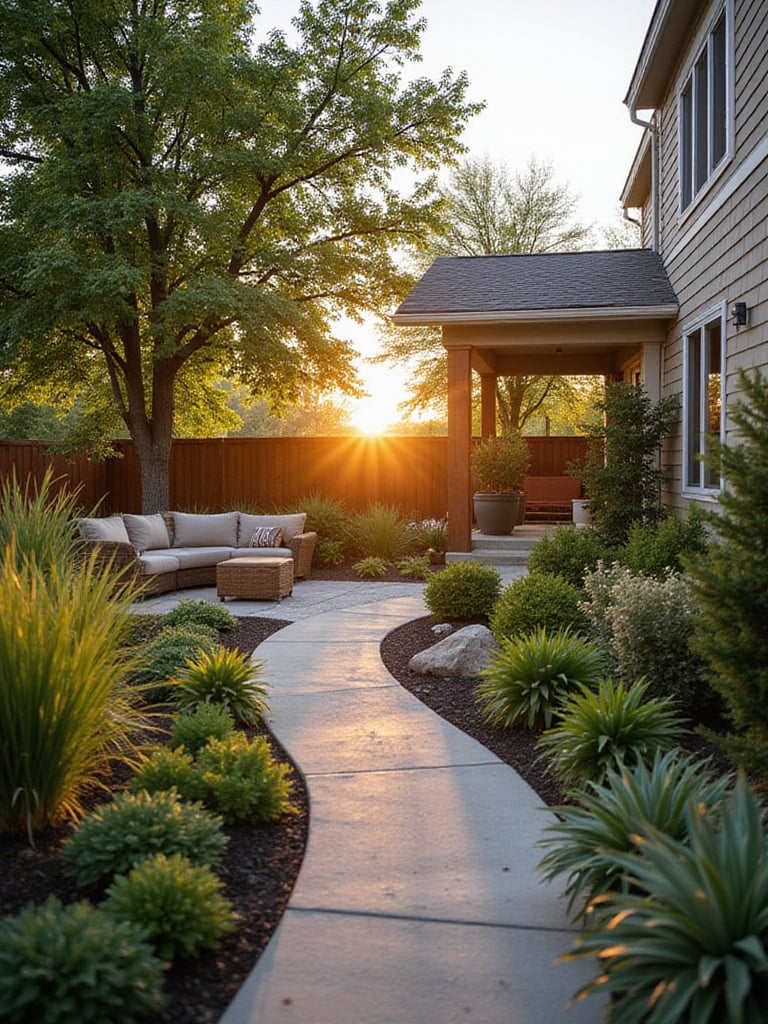
The investment in thorough planning yields measurable returns. Properties with cohesive, well-planned landscapes can see value increases of 5-12% according to the National Association of Realtors, with the most significant gains occurring when the front yard design complements rather than competes with the home’s architecture. Beyond financial benefits, a clearly defined purpose reduces long-term maintenance costs by ensuring every element serves a specific function, eliminating the need for costly corrections or replacements down the line.
- Functional Assessment: List practical requirements such as parking needs, entertaining areas, privacy concerns, pet considerations, or maintenance preferences
- Architectural Analysis: Study your home’s style elements—rooflines, materials, proportions—to inform landscape choices that enhance rather than clash
- Lifestyle Integration: Consider how your family will actually use the front yard space on a daily and seasonal basis
The environmental story behind this piece began with understanding that successful front yard design starts with purpose, not plants. A young family in suburban Denver discovered this when they defined their goal as “welcoming yet low-maintenance for busy schedules.” This clarity led them to choose drought-tolerant perennials over high-maintenance annuals, install permeable pavers instead of traditional concrete, and create a small, defined play area rather than an expansive lawn. The result was a beautiful landscape that actually supported their lifestyle while significantly reducing weekend maintenance time.
2. Conduct Comprehensive Site Analysis for Optimal Plant Success
Understanding your property’s unique environmental conditions—sun patterns, soil composition, drainage characteristics, and microclimates—forms the scientific foundation for sustainable front yard design. This detailed assessment ensures every plant selection and design element aligns with your site’s natural attributes, preventing costly failures and creating conditions for long-term landscape health. Skipping this crucial step often results in struggling plants, excessive water bills, and ongoing frustration with maintenance.
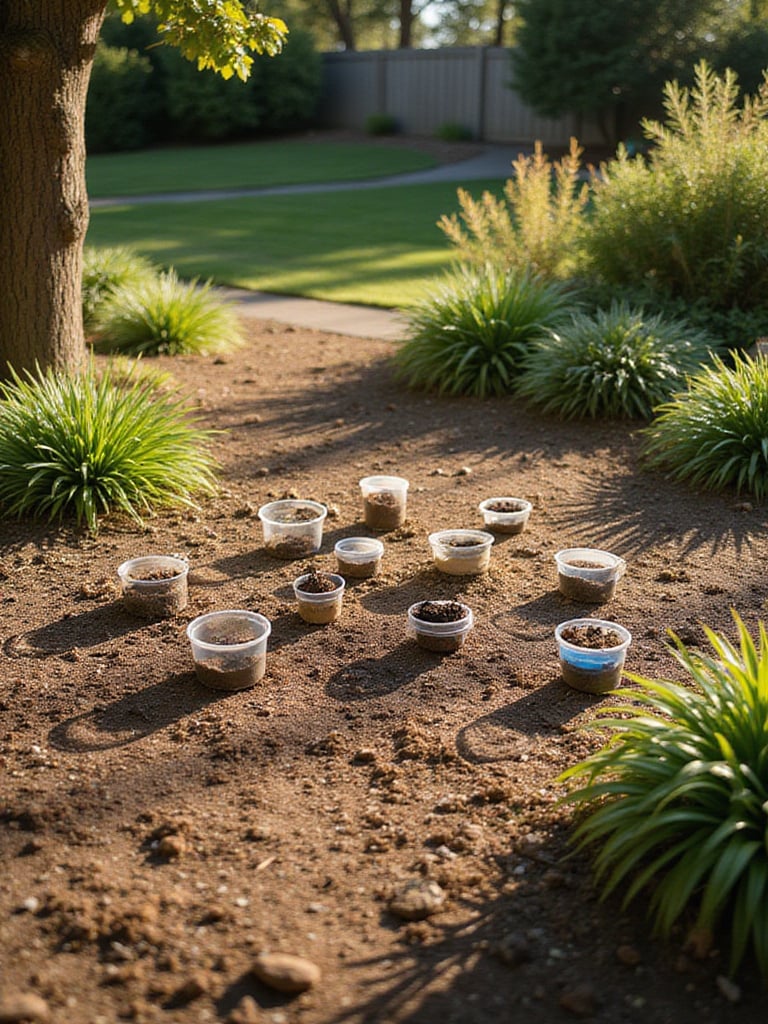
Professional site analysis can reduce plant replacement costs by up to 40% while decreasing water consumption by 20-30% through strategic plant placement based on actual site conditions. The University of California Cooperative Extension reports that selecting appropriate plants for specific sun and soil conditions can reduce outdoor water use by 50-70% compared to traditional landscapes, demonstrating the financial and environmental benefits of informed plant selection.
Conducting your site analysis requires systematic observation over different seasons and times of day. Map sun exposure by noting areas receiving full sun (6+ hours), partial sun (3-6 hours), and shade (less than 3 hours) at various times throughout the day. Evaluate soil conditions by digging test holes in different areas, observing drainage rates, and testing pH levels through your local extension office. Document slope patterns and natural water flow, particularly after heavy rainfall, to identify potential drainage issues or opportunities for water collection.
- Sun Mapping: Track light patterns across seasons, noting how buildings and mature trees create shifting shadow patterns
- Soil Testing: Analyze texture, drainage, pH, and nutrient levels in multiple locations across your front yard
- Microclimate Identification: Observe how wind patterns, reflected heat, and elevation changes create distinct growing conditions
What makes this choice better for our planet is the reduction in failed plantings and unnecessary resource consumption. A homeowner in Phoenix conducted a thorough site analysis and discovered that their east-facing slope created a cooler microclimate perfect for plants that would struggle in full desert sun. By selecting species adapted to these specific conditions, they created a thriving landscape using 60% less water than their previous failed attempts with inappropriate plant choices.
3. Create an Inviting Entryway That Welcomes and Impresses
The entryway serves as your home’s introduction, setting expectations for everything that follows while providing the crucial first impression that influences property value and daily satisfaction. This space extends beyond the front door to encompass the entire approach sequence—from the street view to the threshold crossing. A thoughtfully designed entryway creates an emotional connection that transforms a simple arrival into a welcoming experience.
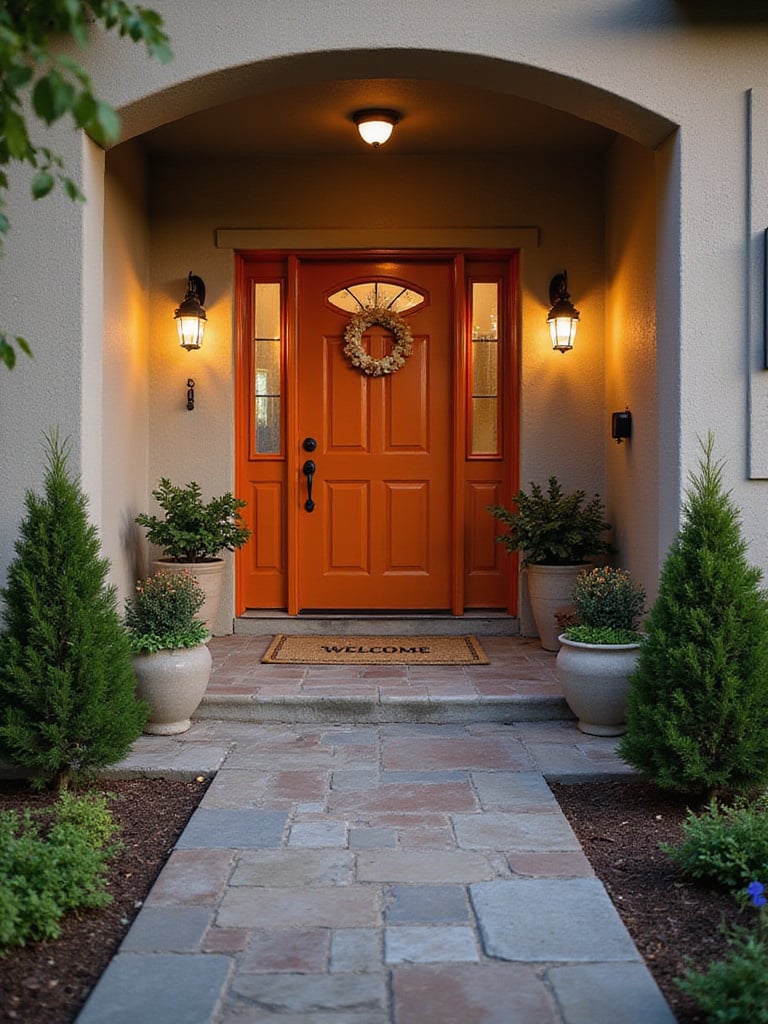
Investment in entryway enhancement typically yields returns of 5-7% in perceived home value, with real estate professionals consistently noting that strong curb appeal, particularly at the entrance, can accelerate sales and increase offers. The 2023 Zillow Group Consumer Housing Trends Report confirms that homes with excellent curb appeal sell for an average of 7% more than comparable properties, with the entryway serving as a primary focal point for buyer attention.
Creating an inviting entryway requires attention to both practical and aesthetic elements. Establish a clear, well-maintained pathway that’s at least 4 feet wide for comfortable passage, using materials that complement your home’s architecture. Install layered lighting—overhead fixtures, flanking sconces, and subtle path illumination—to ensure safety and create ambiance during evening hours. The front door itself deserves special attention: fresh paint in a color that either harmonizes with or thoughtfully contrasts your home’s palette, updated hardware that reflects current style preferences, and clearly visible house numbers.
- Pathway Definition: Create a clear route using complementary materials with proper width for comfortable two-person passage
- Lighting Strategy: Layer ambient, task, and accent lighting for both safety and dramatic evening appeal
- Door Enhancement: Update paint, hardware, and accessories to create a focal point worthy of your home’s architecture
The artisan collective that creates these welcoming spaces understands that details matter most at the threshold. A 1950s ranch home struggling with buyer interest transformed its entrance by painting the front door a sophisticated navy blue, flanking it with matching planters filled with seasonal displays, and installing modern brass sconces. The cohesive update created an immediate sense of quality and care that contributed to multiple offers within two weeks of listing.
4. Design Pathways That Guide and Enhance the Journey Home
A well-designed pathway serves as more than functional access—it creates a sense of journey and anticipation while guiding visitors naturally toward your home’s entrance. This critical hardscape element establishes the rhythm and flow of your front yard design, connecting public and private spaces while contributing significantly to overall curb appeal. The pathway’s material, width, and routing decisions influence both daily usability and long-term property value.
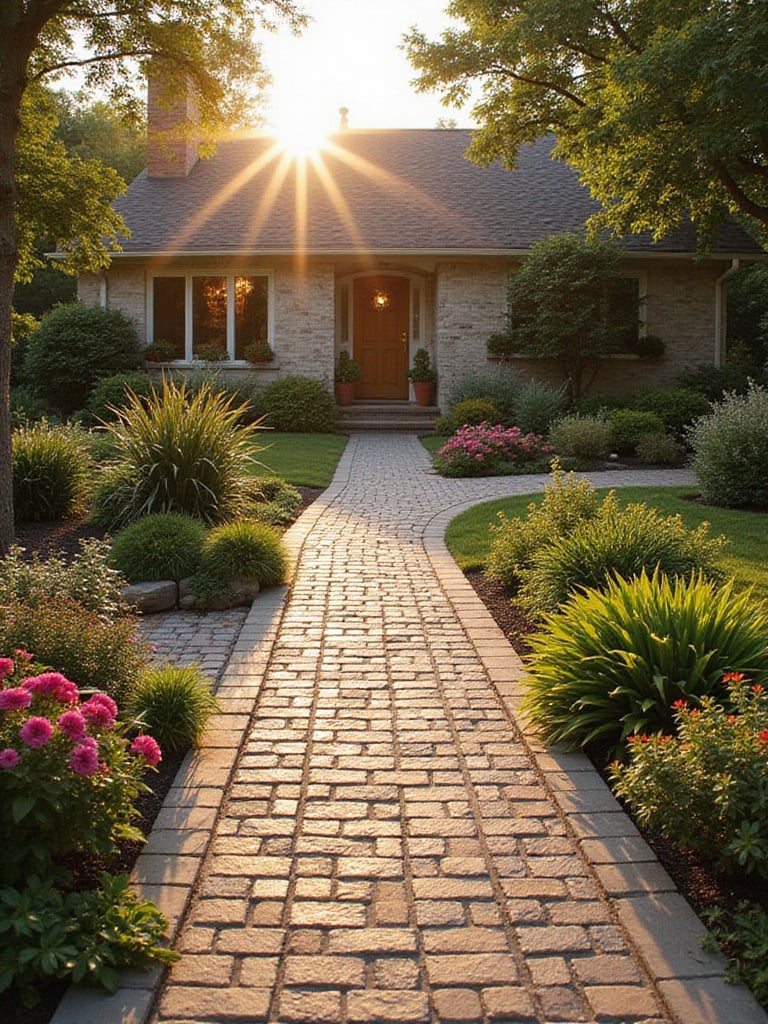
Strategic pathway design can increase perceived property value by 5-10% through enhanced functionality and aesthetic appeal. The National Association of Realtors’ 2023 survey indicates that curb appeal projects, including well-designed walkways, consistently recover 100% of their investment at resale. Beyond financial returns, thoughtful pathways improve accessibility for all users, reduce maintenance through proper drainage and material selection, and create visual connections between landscape elements and architectural features.
Effective pathway design begins with understanding traffic patterns and desired experiences. Consider whether the path should provide direct access or create a more leisurely approach through gentle curves that reveal different landscape vistas. Select materials that complement your home’s architectural style while meeting practical requirements for durability, slip resistance, and maintenance. Natural stone offers timeless elegance but requires more investment, while concrete pavers provide versatility and easier installation with numerous style options.
- Material Selection: Choose surfaces that balance aesthetic appeal with practical considerations like climate resistance and maintenance requirements
- Width Planning: Ensure minimum 4-foot width for main pathways, with wider areas at decision points or gathering spots
- Routing Strategy: Design curves and sight lines that create interest while maintaining clear navigation to the entrance
The unexpected pairing that always works is combining functional pathway design with integrated landscape features. A contemporary home replaced its narrow, straight concrete walk with a wider pathway of large-format pavers interspersed with planted strips of ornamental grasses. The design created visual interest while managing stormwater runoff, demonstrating how thoughtful planning can address multiple needs simultaneously while enhancing the home’s modern aesthetic.
5. Transform Your Driveway into a Design Asset
The driveway represents one of the largest hardscape elements in most front yard designs, yet it’s often treated as purely utilitarian rather than an opportunity for aesthetic enhancement. This significant surface area can either detract from or contribute to your home’s overall appeal, making material selection and edging details crucial considerations. A well-designed driveway seamlessly integrates with the landscape while providing durable, attractive vehicle access.
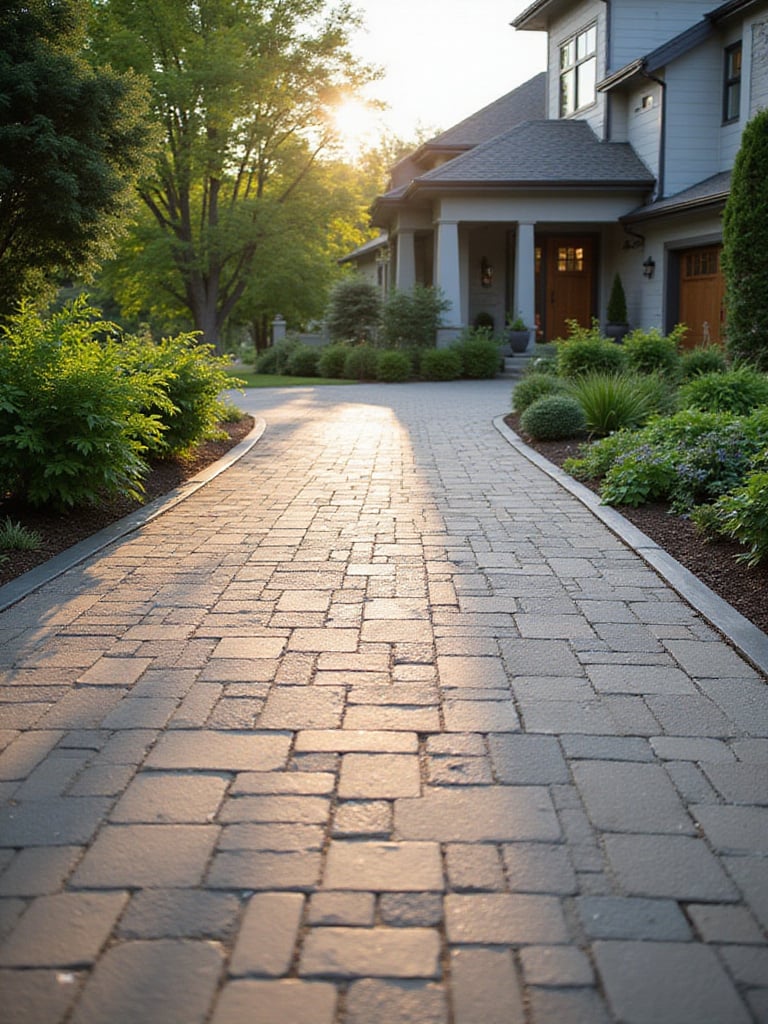
Driveway upgrades typically yield 5-10% increases in perceived home value, with the National Association of Landscape Professionals noting that properties with cohesive hardscape design, including driveways, command premium pricing in competitive markets. Beyond value enhancement, thoughtful driveway design improves functionality through better drainage, reduces long-term maintenance costs through appropriate material selection, and creates visual continuity between architectural and landscape elements.
Evaluating driveway transformation begins with assessing current conditions and future needs. Consider your home’s architectural style, existing drainage patterns, and maintenance preferences when selecting materials. Options range from permeable pavers that manage stormwater while providing elegant surfaces, to stamped concrete that offers design flexibility at moderate cost, to natural stone that provides unmatched character with higher investment requirements. Each choice carries implications for longevity, maintenance, and aesthetic impact.
Proper edging proves essential for containing materials and creating finished appearances. Select edging materials that complement both the driveway surface and your home’s style—steel for contemporary designs, brick for traditional homes, or natural stone for rustic aesthetics. Professional installation ensures proper sub-base preparation and drainage integration, preventing future settling or cracking issues that compromise both function and appearance.
- Permeable Solutions: Consider materials that allow water infiltration to reduce runoff and support environmental goals
- Style Integration: Select surfaces and patterns that echo your home’s architectural language rather than competing with it
- Maintenance Planning: Choose materials appropriate for your climate and maintenance preferences to ensure long-term satisfaction
The collaboration began with a conversation about how driveways could enhance rather than detract from home design. A Tudor-style home transformed its deteriorating asphalt driveway with clay pavers laid in a herringbone pattern, bordered by matching brick edging. The upgrade not only resolved drainage issues but also reinforced the home’s traditional character, contributing to a 12% increase in appraised value.
6. Establish Structure Through Strategic Hardscaping Elements
Strategic hardscaping provides the essential framework that organizes and defines outdoor spaces, creating distinct zones while adding architectural interest to front yard design. These permanent elements—retaining walls, decorative borders, seating areas, and structural features—serve as the landscape’s skeleton, supporting and showcasing softer plantings while contributing year-round visual appeal. Without this foundational structure, even the most beautiful plants can appear scattered and purposeless.
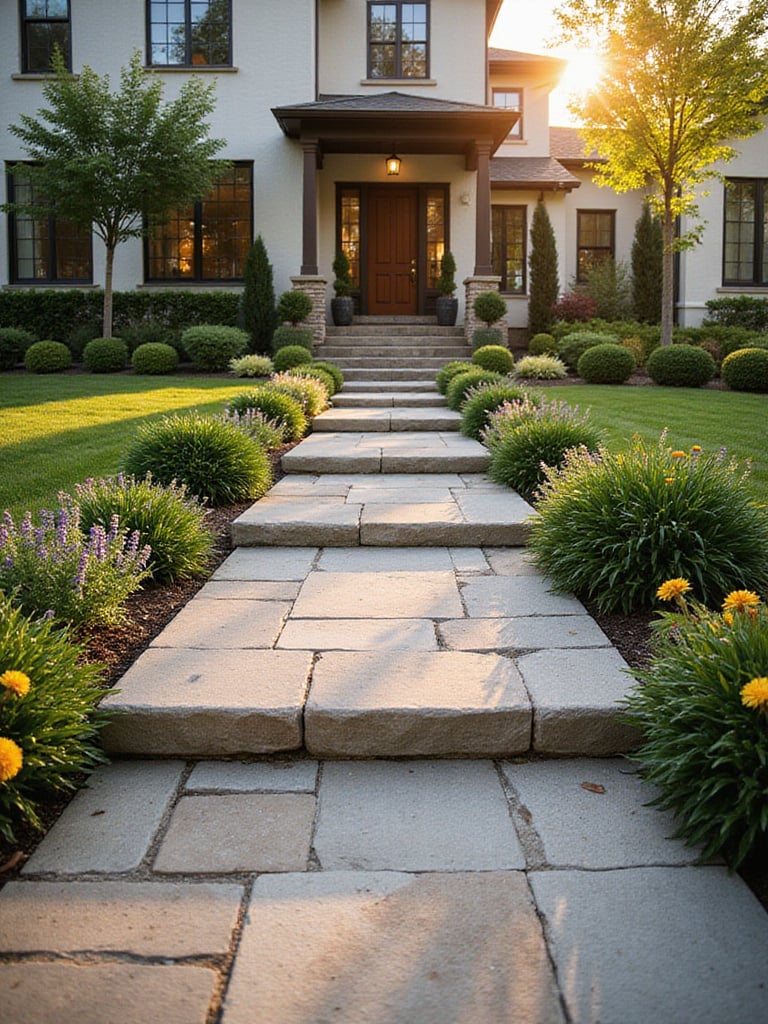
Well-executed hardscaping can increase property value by 7-15%, with the National Association of Realtors reporting that stone patios recover 69% of their cost at resale, while walkways recover 67%. Beyond financial returns, hardscaping reduces maintenance requirements by replacing high-maintenance turf areas with durable surfaces, improves functionality by creating usable outdoor spaces, and provides essential structural support on sloped sites while preventing erosion.
Effective hardscaping begins with understanding your site’s opportunities and constraints. Evaluate topography, drainage patterns, and desired functions to determine where structural elements will provide maximum benefit. Consider how different materials—natural stone, concrete, brick, or composite options—will complement your home’s architecture and existing landscape features. The key lies in creating cohesive design language that unifies rather than fragments the overall composition.
- Zone Definition: Use hardscaping to create distinct areas for different functions while maintaining visual flow between spaces
- Material Harmony: Select surfaces and textures that complement rather than compete with your home’s architectural elements
- Drainage Integration: Incorporate proper water management into hardscape design to prevent future maintenance issues
Installation requires careful attention to foundation preparation and utility considerations. Mark all underground utilities before excavation, plan for proper drainage to prevent water pooling, and ensure adequate base preparation for long-term stability. Professional installation often proves worthwhile for complex features, particularly retaining walls or structures requiring permits.
The challenge of awkward spaces becomes easier when hardscaping provides structure and definition. A split-level home on a steep lot used terraced retaining walls to create three distinct planting levels, transforming an unusable slope into a dramatic landscape feature. The stone walls not only prevented erosion but also created opportunities for varied plant displays while establishing the home as a neighborhood standout.
7. Embrace Drought-Tolerant Plants for Sustainable Beauty
Selecting drought-tolerant plants represents both an environmental commitment and a practical strategy for creating resilient front yard design that thrives with minimal irrigation. These adapted species, often native to your region, provide striking beauty while significantly reducing water consumption, maintenance requirements, and long-term landscape costs. This approach creates gardens that remain vibrant even during challenging weather conditions while supporting local ecosystems.
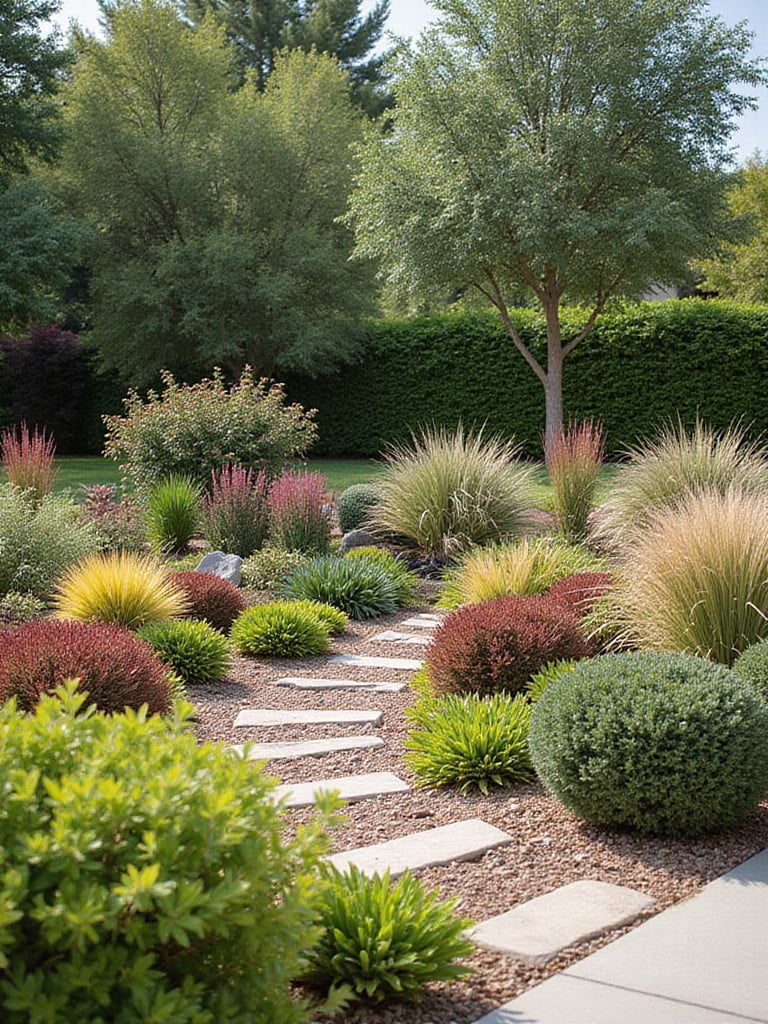
Drought-tolerant landscaping can reduce outdoor water consumption by 50-75%, with the EPA WaterSense program documenting average savings of 8,800 gallons annually per household. These reductions translate to substantial utility bill savings while contributing to broader conservation efforts. Additionally, such landscapes require 30-50% less maintenance due to reduced watering, fertilizing, and pest management needs, while potentially increasing property value by 5-15% as water-wise features become increasingly desirable to buyers.
Successful drought-tolerant design begins with understanding your specific climate and soil conditions. Research plants native to your region, as they’ve evolved to thrive in local conditions without supplemental irrigation once established. Supplement with well-adapted non-native species that aren’t invasive, focusing on plants that provide multiple seasons of interest through varied foliage, flowers, or structural form.
- Native Plant Priority: Focus on species indigenous to your region for optimal adaptation and minimal maintenance requirements
- Soil Preparation: Improve drainage and soil structure to support healthy root development during establishment periods
- Hydrozoning Strategy: Group plants with similar water needs to optimize irrigation efficiency and plant health
Design implementation requires attention to establishment periods and long-term planning. Even drought-tolerant plants need consistent watering during their first growing season to develop deep root systems. Apply organic mulch to conserve moisture, suppress weeds, and regulate soil temperature. Plan for mature plant sizes to prevent overcrowding and ensure adequate air circulation.
The environmental story behind this piece includes supporting local wildlife and reducing chemical inputs. A suburban California home replaced its traditional lawn with a diverse drought-tolerant garden featuring native grasses, succulents, and flowering shrubs. After two years, the homeowners reported 65% reduction in irrigation costs while enjoying increased bird and butterfly activity, demonstrating how sustainable choices can enhance both environmental and aesthetic value.
8. Select Plants for Continuous Seasonal Interest
Creating year-round visual appeal requires selecting plants that provide varying points of interest across all seasons—spring flowers, summer foliage, fall color, winter structure, or persistent berries. This strategic approach ensures your front yard design remains engaging throughout the calendar year, preventing the barren or neglected appearance that affects many landscapes during dormant seasons. Multi-season planning transforms your property into a dynamic display that evolves with natural rhythms.
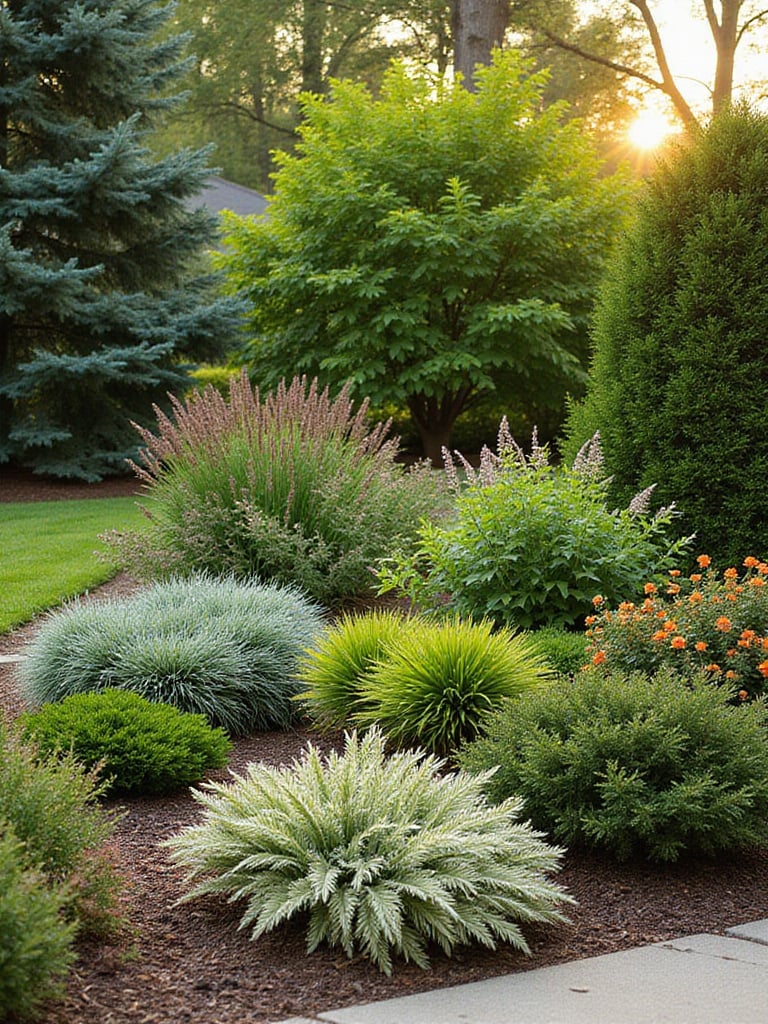
Landscapes designed for continuous interest can recover 100% or more of their installation cost at resale according to joint studies by the National Association of Realtors and National Association of Landscape Professionals. This return stems from consistent curb appeal that attracts potential buyers regardless of viewing season. Additionally, multi-season planning reduces the need for seasonal annuals and frequent replanting, cutting maintenance costs by up to 30% while ensuring reliable performance.
Effective multi-season design requires understanding each plant’s contribution throughout the year. Research not only bloom times but also foliage characteristics, bark interest, fruit or seed head persistence, and structural form during dormancy. Create a calendar mapping when each plant provides peak interest to ensure continuous appeal without gaps in visual engagement.
Layer your selections to provide depth and structure across varying heights. Combine evergreens for consistent backbone, deciduous plants for seasonal drama, and perennials for recurring color and texture. Consider how different plant forms—upright, spreading, weeping, or architectural—contribute to winter interest when foliage is minimal.
- Evergreen Foundation: Include conifers and broadleaf evergreens to maintain structure and color during dormant seasons
- Seasonal Transitions: Plan for smooth progression from spring emergence through fall senescence with overlapping interest periods
- Winter Appeal: Select plants with attractive bark, persistent fruit, or striking architectural form for cold-season beauty
The design language evolved from traditional patterns that emphasized single-season displays toward more sophisticated approaches celebrating natural cycles. A colonial-style home achieved year-round appeal by combining ‘Emerald Green’ arborvitae for winter structure, serviceberry trees for spring flowers and fall color, ‘Annabelle’ hydrangeas for summer blooms and winter texture, and ornamental grasses for movement and seed head interest. This layered approach ensured the landscape remained compelling through all seasons while requiring minimal seasonal maintenance.
9. Master Plant Layering for Visual Depth and Professional Appeal
Layering plants by height creates the dimensional quality that distinguishes professional front yard design from amateur attempts, transforming flat, monotonous landscapes into visually rich compositions. This fundamental technique involves arranging plants from tallest in back to shortest in front, creating depth perception while showcasing each plant’s unique characteristics. Proper layering mimics natural plant communities while ensuring every element contributes to the overall composition.
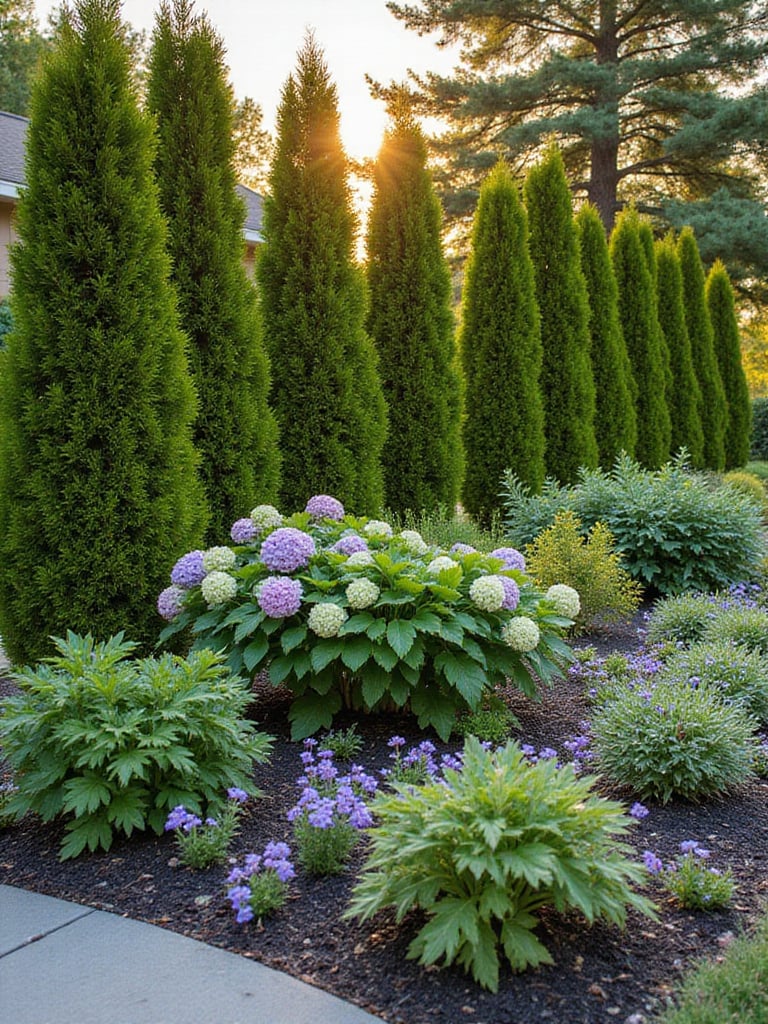
Well-layered landscapes can increase perceived property value by 5-12% through enhanced visual appeal and professional appearance. The technique creates an illusion of greater space in smaller yards while providing year-round structure through varied plant forms and evergreen elements. Additionally, layered plantings support healthier growing conditions by creating beneficial microclimates and reducing maintenance through natural weed suppression and soil protection.
Successful layering begins with understanding mature plant sizes and growth habits to prevent future overcrowding or obscured views. Plan your background layer with taller shrubs, small trees, or upright perennials that provide structure and screening. The middle layer features medium-height plants that add substance while bridging the height gap between background and foreground elements.
The foreground layer completes the composition with low-growing plants that soften edges and provide seasonal color or texture. Consider how different foliage textures, colors, and forms interact to create visual interest beyond simple height variation. Combine fine-textured grasses with broad-leafed perennials, or pair spiky architectural plants with soft, mounding forms.
- Background Structure: Use taller elements to create framework and visual anchors for the entire composition
- Middle Transition: Bridge height gaps with medium plants that add volume without overwhelming smaller elements
- Foreground Detail: Complete the composition with low plants that provide seasonal interest and edge definition
The composition comes together when you consider how light moves through the layered planting throughout the day. A contemporary home created dramatic depth by layering ‘Sky Pencil’ holly as vertical accents, ‘Limelight’ hydrangeas for middle volume, and Japanese painted fern with seasonal annuals for foreground interest. The varied heights and textures transformed a previously flat foundation planting into a sophisticated landscape feature that enhanced the home’s architectural lines.
10. Explore Alternatives to Traditional Turf Lawns
Moving beyond conventional grass lawns opens opportunities for more sustainable, interesting, and lower-maintenance front yard design while addressing water conservation concerns and reducing weekly maintenance requirements. Alternative groundcovers, native grass meadows, or mixed plantings can provide attractive surfaces that better suit contemporary lifestyles and environmental priorities. These options often prove more resilient during drought conditions while supporting local wildlife and reducing chemical inputs.
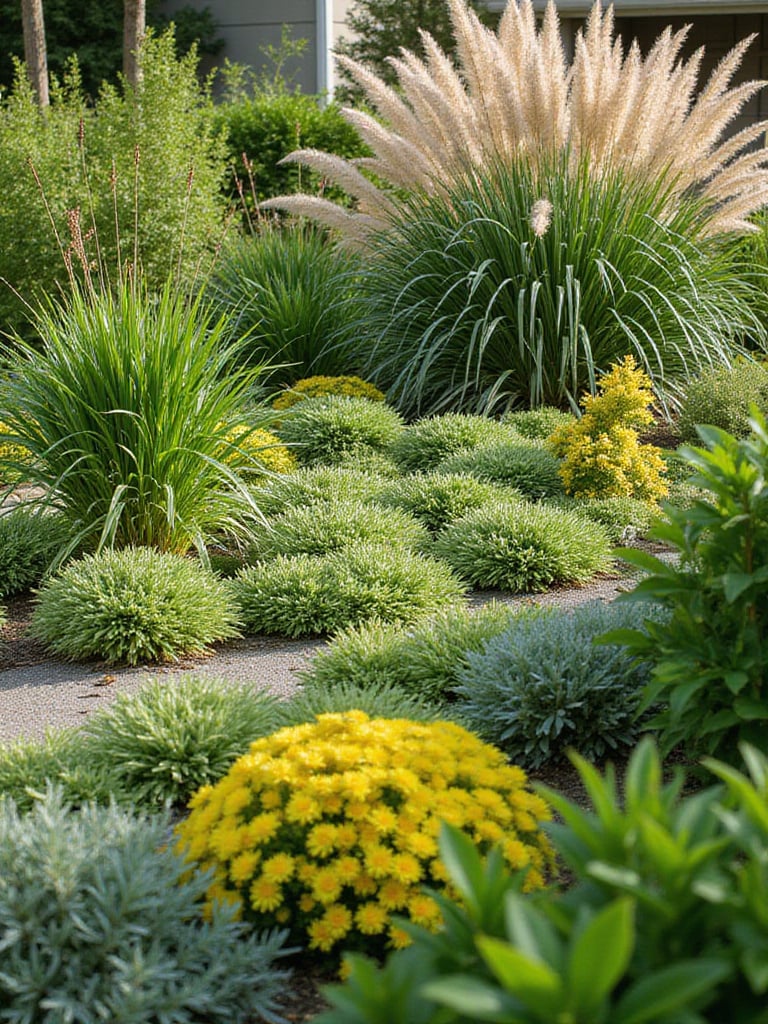
Lawn alternatives can reduce outdoor water consumption by 50-75% compared to traditional turf, with the EPA noting that landscape irrigation accounts for nearly one-third of residential water use nationally. Maintenance time decreases by up to 90% through elimination of regular mowing, while supporting biodiversity through habitat creation for beneficial insects and birds. Property values can increase 3-8% through distinctive, well-designed alternatives that differentiate homes in competitive markets.
Selecting appropriate alternatives requires understanding your site conditions and intended use patterns. Evaluate sun exposure, soil type, foot traffic expectations, and local climate to determine suitable options. Consider groundcovers like creeping thyme or wild strawberry for light foot traffic, ornamental grass meadows for larger areas with minimal access needs, or mixed perennial plantings for high visual impact with moderate maintenance.
Installation success depends on thorough site preparation and appropriate plant selection. Remove existing turf completely through solarization, sheet mulching, or mechanical methods. Amend soil as needed based on testing results, and select plants specifically adapted to your conditions rather than forcing inappropriate species to survive.
- Site-Appropriate Selection: Choose alternatives based on actual growing conditions rather than aesthetic preferences alone
- Traffic Considerations: Match plant choices to expected foot traffic patterns and family usage needs
- Establishment Planning: Provide adequate water and care during the first growing season for successful establishment
The sustainable journey of this material involves reducing resource consumption while increasing ecological value. A suburban home replaced their front lawn with a native grass meadow featuring buffalo grass, wildflowers, and scattered shrubs. The transformation reduced their irrigation needs by 80% while creating habitat for local birds and butterflies, demonstrating how alternatives can provide both environmental and aesthetic benefits.
11. Illuminate Your Landscape with Strategic Lighting Design
Thoughtful lighting extends your front yard design’s impact beyond daylight hours while providing essential safety and security benefits. Strategic illumination highlights architectural features, guides navigation along pathways, and creates dramatic evening ambiance that significantly enhances curb appeal. Well-designed landscape lighting systems can transform ordinary daytime landscapes into extraordinary nighttime experiences while adding functional value to outdoor spaces.
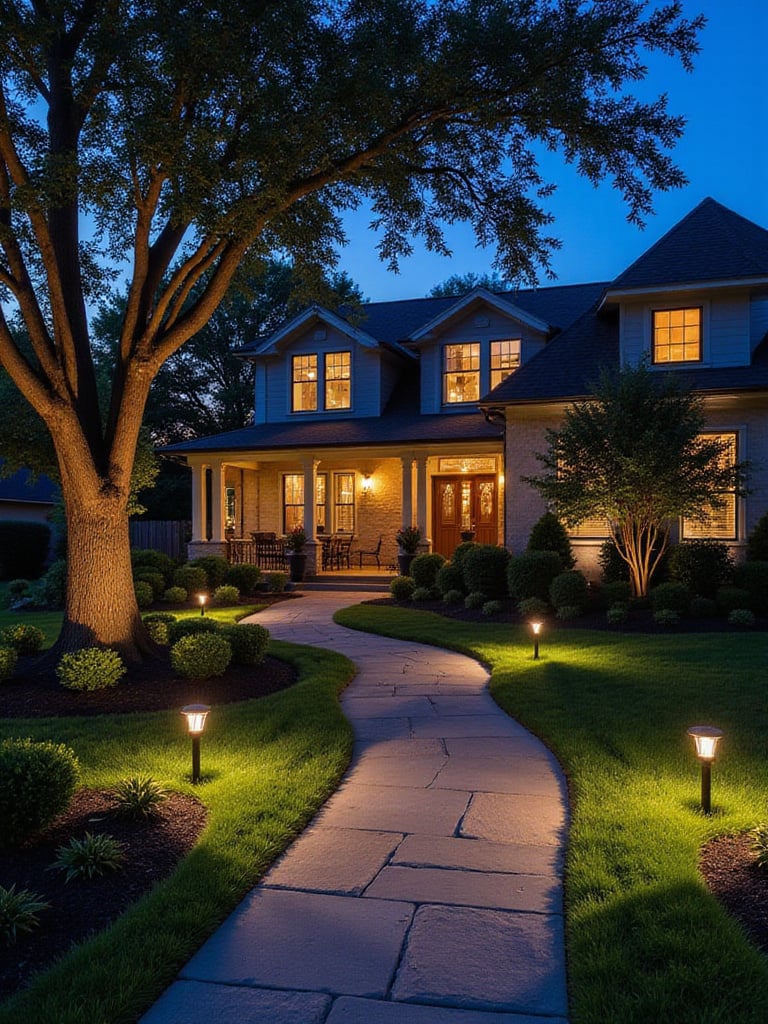
Professional landscape lighting can increase property value by 1-2% while reducing security risks through improved visibility. The U.S. Department of Justice reports that well-lit properties experience 25% fewer security incidents, while proper pathway lighting reduces trip-and-fall accidents by up to 80%. Modern LED systems consume 80% less energy than traditional incandescent options, making dramatic lighting effects affordable to operate year-round.
Effective lighting design requires understanding different illumination types and their appropriate applications. Ambient lighting provides general illumination for safety and navigation, while accent lighting highlights specific features like trees, architectural details, or focal points. Task lighting addresses specific functional needs like steps, entrances, or seating areas. The key lies in layering these different types to create comprehensive coverage without over-illumination.
- Pathway Safety: Install low-level lights along walkways and steps to ensure safe navigation without creating glare
- Feature Highlighting: Use uplights or spotlights to showcase trees, architectural elements, or landscape focal points
- Entry Definition: Illuminate house numbers, doorways, and entrance areas for clear identification and welcoming appeal
Technical considerations include selecting appropriate fixture styles that complement your home’s architecture while providing adequate light distribution. Low-voltage LED systems offer energy efficiency and easier installation, while smart controls enable automated scheduling and dimming capabilities. Proper placement prevents light pollution while maximizing effectiveness.
The finishing touch that elevates the entire look involves integrating lighting with landscape features rather than treating it as an afterthought. A craftsman-style home installed copper path lights along their flagstone walkway, uplights on mature oak trees, and subtle wall washing on their stone foundation. The coordinated system created dramatic evening curb appeal while providing safe access and highlighting the home’s best architectural features.
12. Create Compelling Focal Points That Command Attention
A well-chosen focal point serves as your front yard design’s exclamation mark, drawing the eye and creating visual interest that elevates the entire landscape composition. This singular element—whether a specimen tree, sculptural feature, water element, or architectural detail—provides a destination for the gaze while organizing surrounding plantings and hardscape elements. Strategic focal points transform ordinary landscapes into memorable experiences that significantly enhance curb appeal.
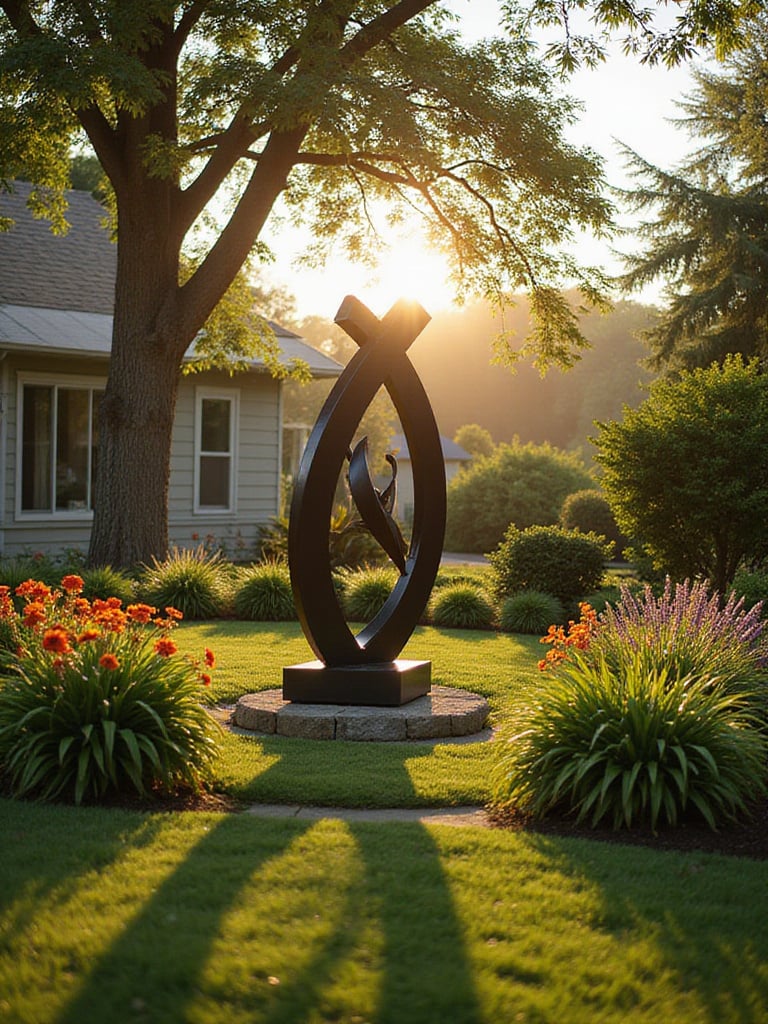
Thoughtfully designed focal points can increase perceived property value by 5-10% through enhanced visual appeal and unique character. Water features specifically can boost home values while providing ambient sound that masks traffic noise and creates peaceful outdoor environments. The key lies in selecting elements that complement rather than compete with your home’s architecture while providing appropriate scale for the surrounding space.
Effective focal point selection begins with identifying primary sight lines from street, driveway, and entrance perspectives. Consider the scale and proportion appropriate for your yard size—small spaces require modest elements while larger areas can accommodate grander features. The focal point should reflect your home’s architectural style and the overall landscape theme for cohesive integration.
Installation considerations include proper foundation preparation, utility access for lighting or water features, and long-term maintenance requirements. Professional installation may be necessary for complex elements like fountains or large sculptures, while careful site preparation ensures stability and longevity for all focal point types.
- Scale Appropriateness: Select focal points sized correctly for your yard and home to maintain visual balance
- Style Integration: Choose elements that complement your home’s architectural character and landscape theme
- Sight Line Optimization: Position focal points where they’ll be most visible and impactful from key viewing angles
The cultural heritage preserved in each piece includes understanding how focal points have traditionally organized landscape compositions. A Mediterranean-style home created a stunning entrance focal point with a tiered fountain surrounded by lavender and rosemary plantings. The water feature provided both visual interest and soothing sound while the aromatic herbs reinforced the home’s architectural theme, creating a cohesive and memorable landscape experience.
13. Define Boundaries with Thoughtful Fencing Solutions
Strategic fencing serves multiple functions in front yard design, providing privacy, security, and property definition while contributing significantly to overall aesthetic appeal. Well-chosen fencing materials and styles can enhance your home’s architectural character while creating intimate outdoor spaces and clearly establishing boundaries. The key lies in selecting options that complement rather than overwhelm the landscape while meeting practical needs for privacy and security.
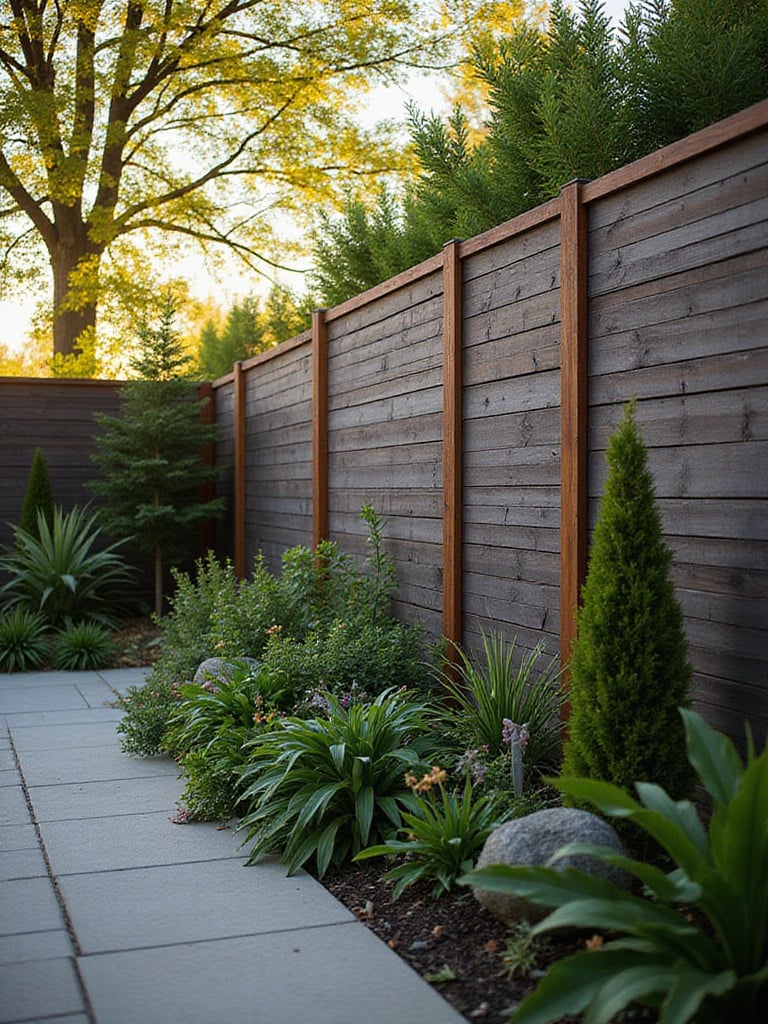
Quality fencing installations can increase property value by 3-7% through enhanced curb appeal and perceived security, with the National Association of Realtors noting that boundary definition ranks among important features for many buyers. Fencing also provides privacy control, reducing visibility into personal spaces by up to 90% for solid options, while clearly defining property lines and creating safe spaces for children and pets.
Successful fencing begins with understanding local regulations, HOA requirements, and permit needs regarding height restrictions, setback requirements, and approved materials. Consider your primary objectives—complete privacy, partial screening, decorative accent, or security enhancement—to guide material and style selection. Options range from traditional wood and vinyl to contemporary metal and composite materials, each offering different maintenance requirements and aesthetic impacts.
Design integration proves crucial for successful fencing projects. Select materials and colors that complement your home’s architecture and existing landscape elements. Consider how the fence will appear from both inside and outside your property, ensuring it enhances rather than detracts from curb appeal.
- Regulatory Compliance: Research local codes, HOA guidelines, and permit requirements before installation
- Material Selection: Choose fencing materials appropriate for your climate, maintenance preferences, and architectural style
- Landscape Integration: Plan for softening elements like climbing plants or shrub borders to enhance visual appeal
Installation quality affects both function and longevity, making professional installation worthwhile for complex projects or challenging sites. Proper post setting, adequate drainage, and quality hardware ensure long-term performance and appearance.
Beyond the obvious placement, consider using fencing as a backdrop for climbing plants or layered plantings that soften hard edges while adding seasonal interest. A contemporary home installed horizontal cedar slat fencing with integrated planters, creating privacy while providing structure for a vertical garden that enhanced both function and beauty.
14. Perfect the Details: Mailbox and House Number Updates
Small details like mailboxes and house numbers significantly impact first impressions while serving essential functional purposes in front yard design. These elements often receive minimal attention yet play crucial roles in creating cohesive, polished appearances that signal quality and attention to detail. Updated, well-maintained address markers and mail receptacles contribute to overall curb appeal while ensuring clear property identification for visitors and service providers.
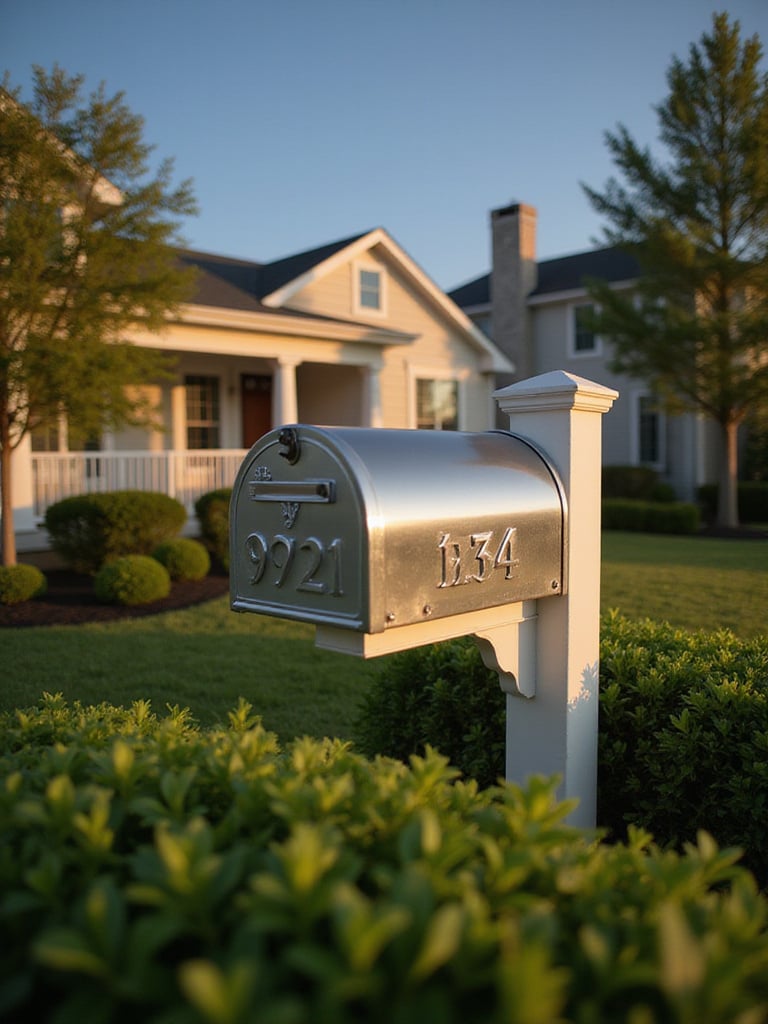
Seemingly minor updates can elevate perceived home value by 2-5% through enhanced first impressions and cohesive design details. The HomeLight Top Agent Insights Report identifies curb appeal as the primary factor influencing buyer interest, with 94% of agents emphasizing its importance. Beyond value considerations, clear, well-lit house numbers improve emergency response times while attractive mailboxes contribute to neighborhood aesthetics and property pride.
Effective updates begin with assessing your home’s architectural style and existing exterior finishes to guide material and style selection. Consider finishes like brushed nickel, matte black, or bronze that coordinate with door hardware, lighting fixtures, and other exterior elements. Ensure house numbers provide adequate size and contrast for easy street visibility, particularly during evening hours.
- Style Coordination: Select finishes and materials that complement existing exterior fixtures and architectural details
- Visibility Requirements: Ensure house numbers meet size and contrast standards for clear identification from the street
- Weather Resistance: Choose materials appropriate for your climate to maintain appearance over time
Installation considerations include proper mounting techniques, adequate lighting for nighttime visibility, and compliance with postal service requirements for mailbox placement. Regular maintenance keeps these elements looking fresh and functioning properly.
The investment value comes from the exceptional attention to detail that signals overall property care. A ranch-style home updated their faded brass numbers and rusted mailbox with large, modern matte black numbers and a sleek wall-mounted mailbox. The coordinated update instantly modernized the home’s appearance while improving functionality, contributing to faster sale and higher offers when the property was later listed.
15. Address Drainage Issues for Long-Term Landscape Health
Proper drainage management forms the invisible foundation of successful front yard design, preventing water damage to structures while ensuring optimal growing conditions for plants. Effective water management directs rainfall away from foundations, eliminates standing water that kills plants and creates mosquito breeding grounds, and prevents soil erosion that undermines landscape investments. Addressing drainage proactively prevents costly repairs while supporting healthy, thriving landscapes.
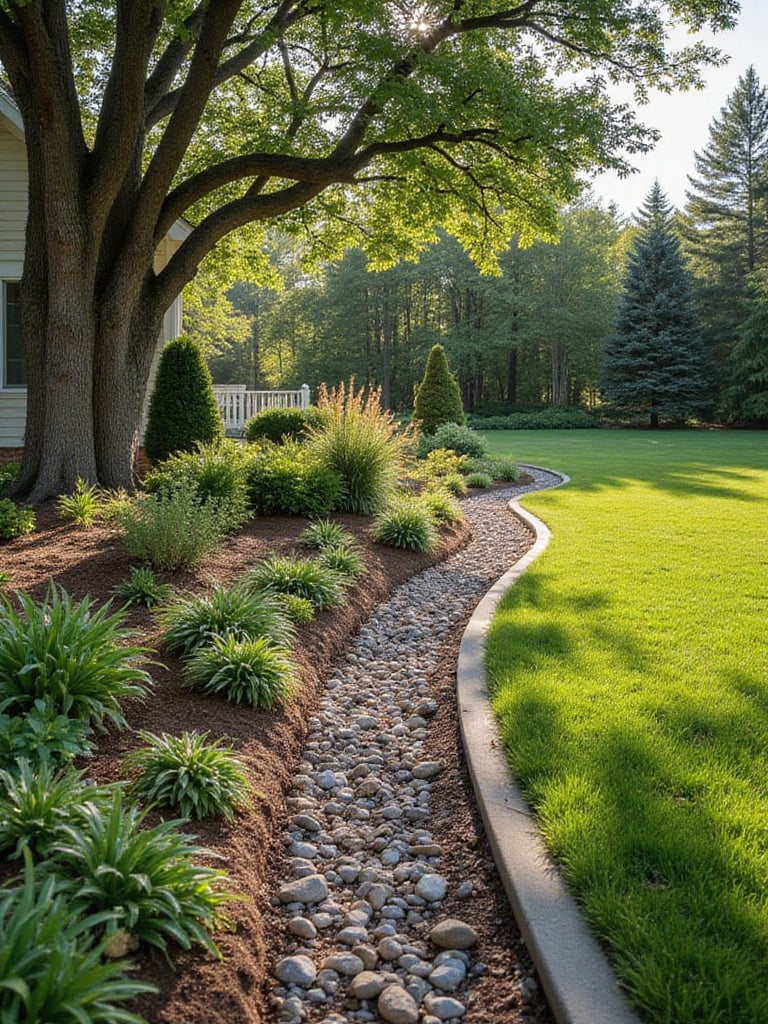
Effective drainage systems can reduce foundation damage risk by up to 60% while preventing the costly water damage claims that insurance industry data shows frequently result from poor site drainage. Proper water management also enhances plant health by eliminating waterlogged conditions that cause root rot and fungal diseases, while preventing soil erosion that degrades landscape beds and hardscape installations.
Drainage assessment begins with observing water flow patterns during heavy rainfall, identifying low spots where water collects, and noting areas where runoff creates erosion problems. Simple solutions include extending downspouts away from foundations, installing splash blocks, and adjusting grading to direct water flow appropriately. More complex issues may require French drains, catch basins, or professional regrading.
- Flow Pattern Analysis: Observe water movement during storms to identify problem areas and natural drainage opportunities
- Foundation Protection: Ensure all water sources direct away from building foundations with proper grading and extensions
- Erosion Prevention: Address slopes and concentrated flow areas that cause soil loss and landscape damage
Professional consultation may be necessary for complex drainage issues or properties with significant elevation changes. Proper installation of drainage systems requires understanding soil conditions, local regulations, and long-term maintenance requirements.
The environmental benefit comes from managing stormwater responsibly while protecting property investments. A suburban home experiencing recurring basement moisture installed a comprehensive drainage system including extended downspouts, a French drain along the foundation, and bioswales to manage runoff. The investment eliminated water problems while creating attractive landscape features that enhanced both function and beauty.
16. Implement Smart Irrigation for Water Conservation
Smart irrigation technology represents the evolution of water management in contemporary front yard design, utilizing weather data, soil sensors, and plant-specific programming to optimize water usage while maintaining healthy landscapes. These systems automatically adjust watering schedules based on actual conditions rather than arbitrary timers, preventing overwatering while ensuring plants receive adequate moisture. Smart irrigation supports both environmental responsibility and landscape health through precision water management.
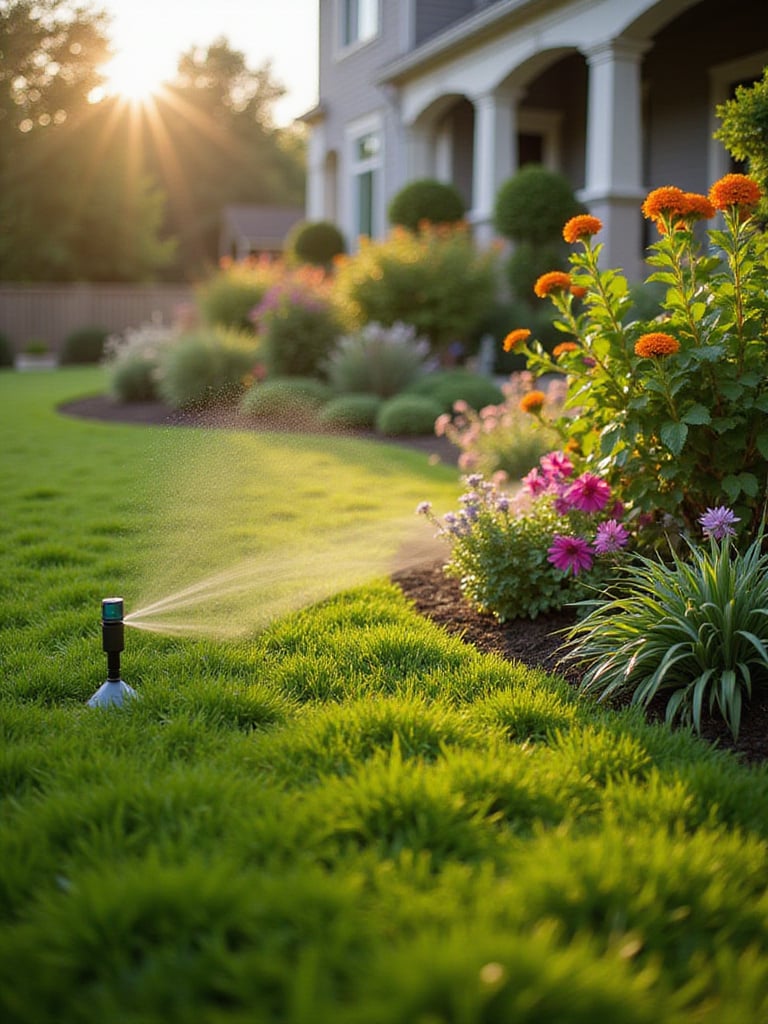
Smart irrigation systems can reduce outdoor water consumption by 30-50%, with the EPA WaterSense program documenting average annual savings of 8,800 gallons per household. These reductions translate to substantial utility bill savings while supporting broader conservation efforts. Additionally, optimized watering improves plant health by delivering appropriate moisture levels, reducing disease pressure from overwatering while preventing stress from drought conditions.
System selection depends on landscape complexity and specific site conditions. Weather-based controllers use local meteorological data to adjust watering schedules, while soil moisture sensors provide direct feedback about actual ground conditions. Consider your landscape’s diversity, sun exposure variations, and plant water requirements when choosing between system types.
- Technology Options: Evaluate weather-based versus soil sensor systems based on your landscape’s complexity and monitoring preferences
- Zone Programming: Design irrigation zones based on plant water needs, sun exposure, and soil conditions for optimal efficiency
- Seasonal Adjustment: Program systems to adapt watering schedules for seasonal plant needs and weather patterns
Installation success requires proper sensor placement, accurate zone programming, and regular system monitoring during establishment periods. Professional installation ensures optimal sensor positioning and system calibration for maximum water savings and plant health.
The unexpected environmental benefit comes from supporting healthier plant communities through consistent, appropriate watering that strengthens root systems and improves drought tolerance. A Phoenix homeowner installed a weather-based smart controller for their diverse front yard landscape, reporting 45% reduction in water usage while maintaining healthier plants that required less replacement and care.
17. Design for Minimal Maintenance Without Sacrificing Beauty
Creating beautiful front yard design that requires minimal ongoing maintenance involves strategic plant selection, efficient systems, and thoughtful hardscaping that reduces labor-intensive tasks while maintaining year-round appeal. This approach prioritizes native and adapted plants, incorporates efficient irrigation and mulching strategies, and utilizes hardscape elements to minimize high-maintenance lawn areas. The goal is sustainable beauty that fits contemporary lifestyles without constant weekend work requirements.
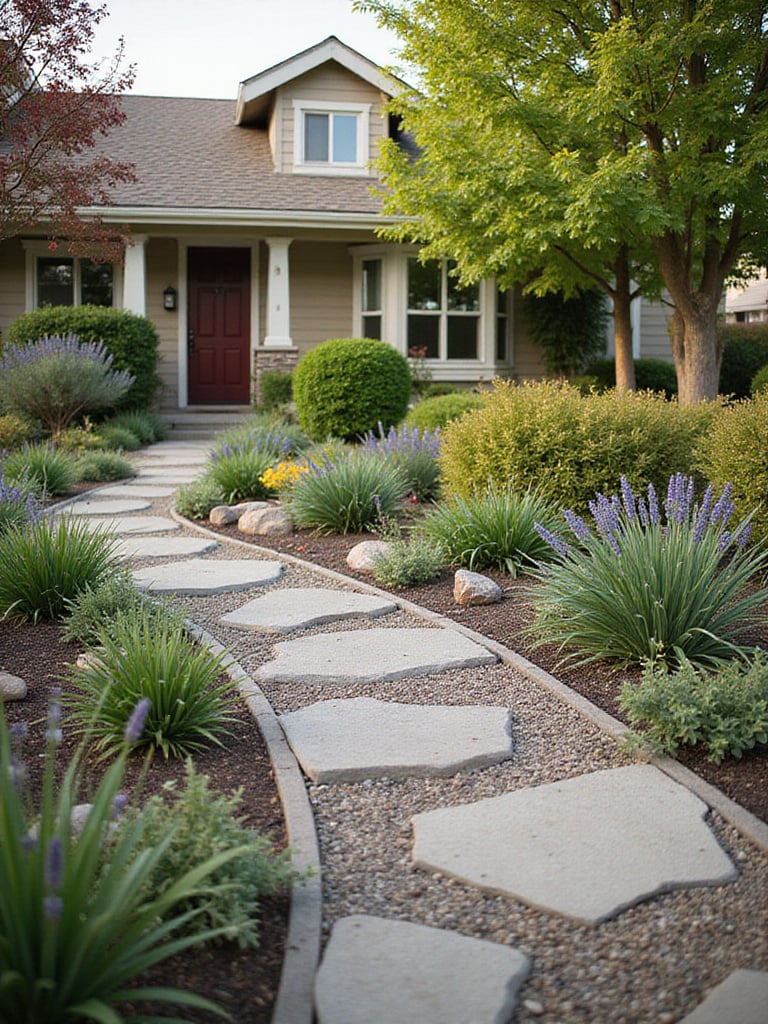
Low-maintenance landscapes can reduce weekly yard work by 3-5 hours while cutting annual maintenance costs by up to 25% through reduced need for fertilizers, pesticides, and plant replacements. The average homeowner spends approximately 100 hours annually on landscape maintenance, with 60% dedicated to mowing and weeding. Strategic design can reclaim significant time while maintaining attractive curb appeal that supports property values.
Maintenance reduction begins with selecting plants adapted to your specific growing conditions rather than species requiring special care or frequent intervention. Native plants typically require minimal supplemental watering, fertilizing, or pest control once established. Incorporate efficient irrigation systems like drip lines or smart controllers that deliver water precisely where needed without waste or overwatering.
Hardscaping strategies include replacing high-maintenance lawn areas with attractive alternatives like groundcovers, ornamental grasses, or permeable paving materials. Generous mulch application suppresses weeds, conserves moisture, and reduces the need for frequent watering and cultivation.
- Plant Selection: Prioritize native and adapted species that thrive in your conditions without intensive care requirements
- Irrigation Efficiency: Install systems that deliver water precisely where needed while minimizing waste and maintenance
- Hardscape Integration: Use permanent materials to reduce lawn areas and create attractive, low-maintenance surfaces
Design simplicity often yields the most sustainable results, with clean lines and grouped plantings proving easier to maintain than complex, scattered arrangements. Consider how mature plant sizes will affect long-term care requirements and plan accordingly.
The maker’s journey from apprentice to master influenced understanding that truly successful landscapes work with natural processes rather than against them. A busy professional couple replaced their high-maintenance front lawn with drought-tolerant perennials, ornamental grasses, and decorative gravel paths. The transformation reduced their weekly yard work from four hours to thirty minutes while creating a distinctive landscape that enhanced their home’s contemporary character.
18. Integrate Sustainable Practices for Environmental Stewardship
Incorporating eco-friendly practices into front yard design creates landscapes that support environmental health while reducing resource consumption and maintenance requirements. Sustainable approaches include native plant selection, water conservation strategies, soil health improvement, and wildlife habitat creation that contribute to broader ecological well-being. These practices often prove more economical long-term while creating distinctive landscapes that reflect environmental consciousness.
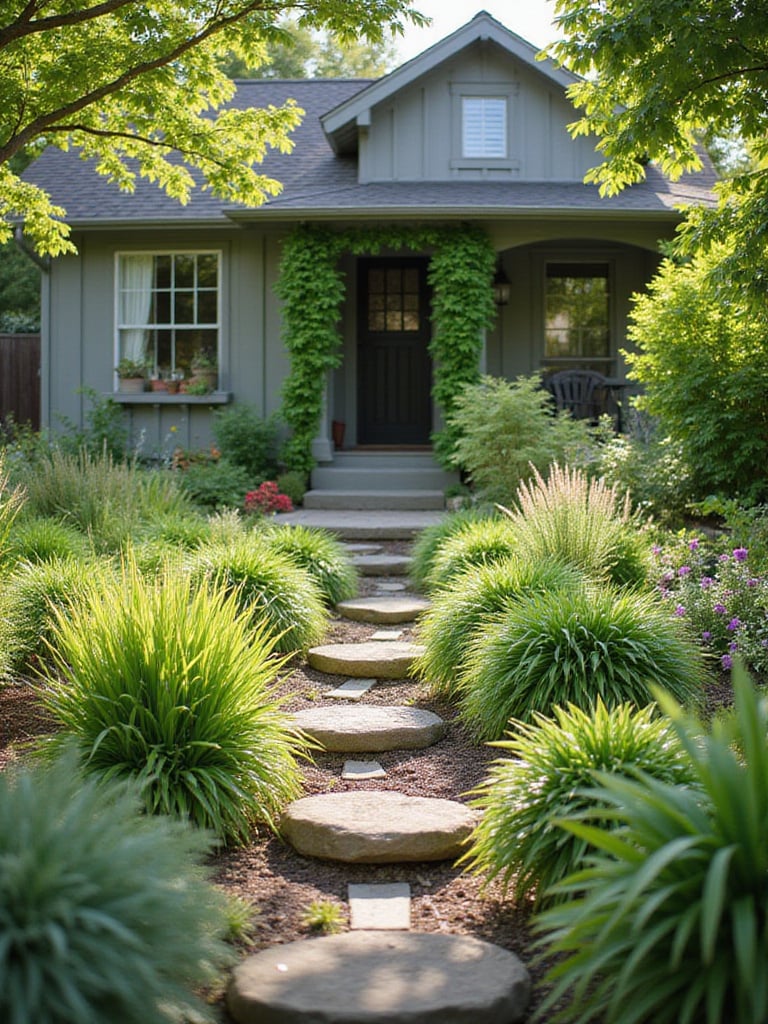
Sustainable landscaping can reduce water consumption by 50-75% through drought-tolerant plant selection and efficient irrigation practices, with the EPA noting that residential outdoor water use accounts for over 9 billion gallons daily nationwide. Eco-friendly practices also enhance local biodiversity by providing habitat and food sources for beneficial insects, birds, and other wildlife while reducing chemical inputs that affect soil and water quality.
Environmental stewardship begins with understanding your local ecosystem and selecting plants that support rather than disrupt natural processes. Native species provide essential resources for local wildlife while requiring minimal inputs once established. Soil health improvement through organic matter addition and mulching creates better growing conditions while supporting beneficial soil organisms.
Water management strategies include rainwater harvesting, permeable surfaces that allow infiltration, and bioswales that filter runoff while creating attractive landscape features. These approaches reduce stormwater impacts while providing irrigation resources during dry periods.
- Native Plant Priority: Focus on indigenous species that support local ecosystems while requiring minimal maintenance inputs
- Water Conservation: Implement harvesting, efficient irrigation, and drought-tolerant design to minimize consumption
- Soil Health: Build organic matter and beneficial soil biology through composting and minimal chemical intervention
Integrated pest management using beneficial insects, companion planting, and manual removal reduces reliance on chemical pesticides while maintaining healthy plant communities. Composting yard waste and kitchen scraps creates valuable soil amendments while reducing waste disposal.
The renewable resources used here demonstrate how sustainable practices can enhance both environmental and aesthetic value. A suburban property transformed their conventional landscape into a native plant garden featuring regional wildflowers, grasses, and shrubs. The change reduced irrigation needs by 70% while attracting numerous bird and butterfly species, creating a vibrant ecosystem that provided year-round interest and environmental benefits.
Conclusion
Transforming your front yard represents far more than a simple home improvement project—it’s an investment in your property’s future, your daily quality of life, and your contribution to environmental stewardship. Through these eighteen strategic approaches to front yard design, we’ve explored how thoughtful planning, informed plant selection, and sustainable practices can create landscapes that enhance both beauty and functionality while supporting long-term value.
The journey from vision to reality requires patience and attention to detail, but the rewards extend well beyond initial curb appeal improvements. Whether you’re addressing drainage challenges, incorporating smart irrigation technology, or selecting plants for year-round interest, each decision contributes to a cohesive outdoor environment that reflects your personal style while meeting practical needs. The most successful transformations occur when homeowners embrace both the aesthetic and functional aspects of landscape design, creating spaces that truly enhance their daily lives.
Remember that exceptional front yard design evolves gradually, allowing you to implement changes systematically while learning what works best for your specific site and lifestyle. Start with foundational elements like drainage and pathway design, then build upon these basics with strategic plant selection and focal point features. Your front yard serves as your home’s public introduction—invest in making that first impression both memorable and meaningful, creating an outdoor space that brings pride and pleasure for years to come.
